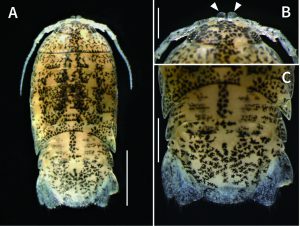Abstract / Introduction / Summary:

Tachaea chinensis Thielemann, 1910 is an ectoparasite of freshwater shrimps and prawns in East Asia. Japan is located at the northern limit of the geographical distribution of the species, but much remains poorly studied on its distribution in northern Japan, where it has been reported only from Aomori Prefecture, the northernmost region on Honshu Island. Five non-ovigerous females of T. chinensis were collected with a scoop net from a small reservoir in Hanamaki City, Iwate Prefecture, south of Aomori Prefecture. Although their shrimp hosts were not examined in the reservoir, this collection of T. chinensis represents its first and second records from Iwate Prefecture and northern Honshu, respectively. The five collected individuals of T. chinensis were transported alive to the laboratory in nearby Miyagi Prefecture, where three of them were released into a small plastic aquarium tank containing an adult freshwater prawn, Macrobrachium nipponense (De Haan, 1849). Immediately after released, two of the three individuals became attached individually to the right and left sides of the carapace of the prawn, but the remaining one individual could not settle on the host. This experiment suggests that freshwater shrimps and prawns including M. nipponense can be used as experimental laboratory hosts to study various aspects of the biology of T. chinensis. This paper also discusses the importance of sediment-rooted emergent aquatic macrophytes as the habitats of freshwater shrimps and T. chinensis.
